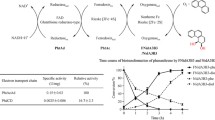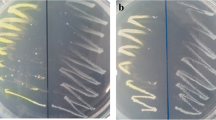Abstract
Nitrobenzene is degraded to pyruvate and acetaldehyde by Pseudomonas pseudoalcaligenes JS45 via a reductive pathway, and by Comamonas sp. JS765 via an oxidative pathway. Although the initial reactions in the degradation of nitrobenzene by the two bacteria are totally different, the lower pathways are similar and converge at the level of 4-oxalocrotonate. In order to further investigate the biochemical properties and reveal the evolutionary relationships between the two lower pathways, the genes encoding the 2-aminophenol 1,6-dioxygenase were cloned and sequenced. 2-Aminophenol 1,6-dioxygenase from P. pseudoalcaligenes JS45 and catechol 2,3-dioxygenase from Comamonas sp. JS765 were able to act on both catechol and 2-aminophenol, but catechol was a suicide substrate of 2-aminophenol 1,6-dioxygenase. The activity of 2-aminophenol 1,6-dioxygenase was restored after removal of catechol and incubation with ascorbate and FeCl2. Both the α-subunit (AmnA) and the β-subunit (AmnB) of the dioxygenase from P. pseudoalcaligenes JS45 show a high degree of identity to the corresponding subunits of the ring-fission dioxygenase from Pseudomonas sp. AP-3: 67% for the α-subunit, and 84% for the β-subunit. Sequence similarity studies suggest that the β-subunits of both 2-aminophenol 1,6-dioxygenases are distantly related to homoprotocatechuate 2,3-dioxygenase from Escherichia coli strains W and C and then to catechol 2,3-dioxygenase from Alcaligenes eutrophus. Four active-site-relevant histidines are conserved in AmnB, but not in AmnA. The lack of conserved histidines indicates the absence of an Fe2+ binding site in AmnA, which explains the previous observations of only approximately one Fe2+ per two subunits in the 2-aminophenol 1,6-dioxygenases from P. pseudoalcaligenes JS45. The 2-aminophenol 1,6-dioxygenase genes are located upstream of the 2-aminomuconic semialdehyde dehydrogenase gene, and a putative member of the YjgF protein family is upstream of the dioxygenase genes. Transcriptional analysis indicates that the YjgF-like protein, 2-aminophenol 1,6-dioxygenase, and 2-aminomuconic semialdehyde dehydrogenase are coordinately transcribed. A putative ORF similar to part of the RNA helicase genes is downstream of the dehydrogenase gene. Both the novel organization of the genes and the phylogeny of the dioxygenases and dehydrogenase indicate that the 2-aminophenol pathway in P. pseudoalcaligenes JS45 represents an example of a distant divergent evolution of meta-cleavage pathways.
Similar content being viewed by others
Author information
Authors and Affiliations
Additional information
Received: 29 March 1999 / Accepted: 10 August 1999
Rights and permissions
About this article
Cite this article
Davis, J., He, Z., Somerville, C. et al. Genetic and biochemical comparison of 2-aminophenol 1,6-dioxygenase of Pseudomonas pseudoalcaligenes JS45 to meta-cleavage dioxygenases: divergent evolution of 2-aminophenol meta-cleavage pathway. Arch Microbiol 172, 330–339 (1999). https://doi.org/10.1007/s002030050787
Issue Date:
DOI: https://doi.org/10.1007/s002030050787




